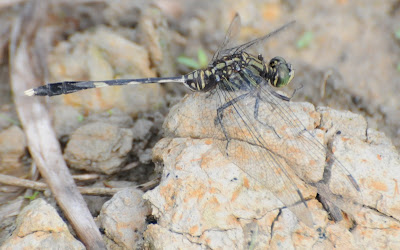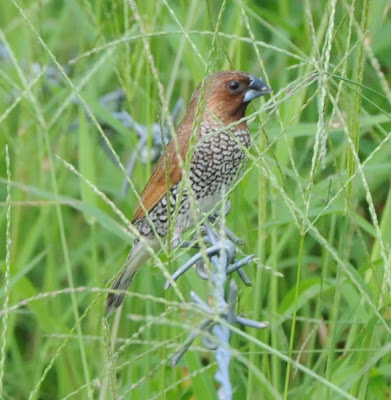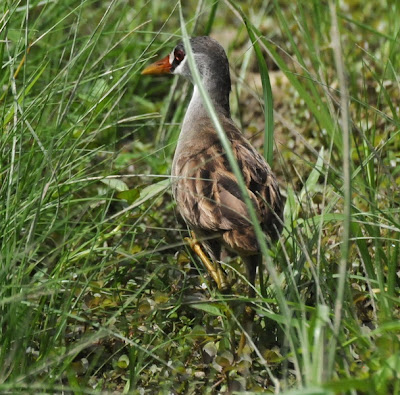Though our stopover in Kuching was a brief one, it did give me time to join my friends in the local Malaysian Nature Society branch on a birding trip to the rice paddies of Chupak, some 50 kilometers south of town.
Chupak is one of the few places around Kuching where you can see freshwater birds, and at this time of year the freshly planted padi is still low enough to give a visiting birder a reasonably clear view of things.
I'm not sure what the workers on the padis think of the strange-looking people, sporting spotting scopes and long lenses, that invade their territory at regular intervals!
Freshwater wetlands good for birds can be hard to come by in Sarawak, so we're glad of this one. So, I suppose, are the migrant Wood Sandpipers (Tringa glareola) that flock here in considerable numbers.
Chupak is also a good place for other waders, including snipes of one species or another and this Ringed Plover (Charadrius hiaticula).
Some of the birders, though, left a bit early. My friend Vincent Wong and I lingered, looking over the paddies to see what else we could find.
Chupak is one of the few places around Kuching where you can see freshwater birds, and at this time of year the freshly planted padi is still low enough to give a visiting birder a reasonably clear view of things.
I'm not sure what the workers on the padis think of the strange-looking people, sporting spotting scopes and long lenses, that invade their territory at regular intervals!
Freshwater wetlands good for birds can be hard to come by in Sarawak, so we're glad of this one. So, I suppose, are the migrant Wood Sandpipers (Tringa glareola) that flock here in considerable numbers.
Chupak is also a good place for other waders, including snipes of one species or another and this Ringed Plover (Charadrius hiaticula).
Some of the birders, though, left a bit early. My friend Vincent Wong and I lingered, looking over the paddies to see what else we could find.
While Vincent scanned for likely birds, I checked out other padi life: the inescapable Orthetrum sabina...
...a giant carpenter bee (Xylocopa latipes)...
and an attractively-patterned Grass Frog (Fejervarya limnocharis).
Waders (or shorebirds, if you prefer) aren't the only birds to be had at Chupak. Munias descend on the pads to feed on grains of rice. This one, the Spotted Munia (Lonchura striata), is even called "ricebird" in some parts of its range (including Hawaii, where it is an introduced exotic).
This is an immature.
If you are very lucky, you can even turn up rails. We were indeed lucky, and had excellent looks at a very attractive White-browed Crake (Porzana cinerea), a widespread species that ranges from Southeast Asia to Tropical Australia. It is less shy than other crakes, and consequently fairly easy to see in the right places.
I was feeling quite worn out by the time we headed back to the car (it gets pretty hot out there by midday), but there is nothing like a good bird to make a birder forget his discomforts.
Our good bird was another rail, this time a Buff-banded Rail (Gallirallus philippensis), flushed from the roadside but soon lured back into view with a recording of its rather feeble call. I didn't get a usable photo, but Vincent has kindly provided me with this one.
...a giant carpenter bee (Xylocopa latipes)...
and an attractively-patterned Grass Frog (Fejervarya limnocharis).
Waders (or shorebirds, if you prefer) aren't the only birds to be had at Chupak. Munias descend on the pads to feed on grains of rice. This one, the Spotted Munia (Lonchura striata), is even called "ricebird" in some parts of its range (including Hawaii, where it is an introduced exotic).
This is an immature.
If you are very lucky, you can even turn up rails. We were indeed lucky, and had excellent looks at a very attractive White-browed Crake (Porzana cinerea), a widespread species that ranges from Southeast Asia to Tropical Australia. It is less shy than other crakes, and consequently fairly easy to see in the right places.
I was feeling quite worn out by the time we headed back to the car (it gets pretty hot out there by midday), but there is nothing like a good bird to make a birder forget his discomforts.
Our good bird was another rail, this time a Buff-banded Rail (Gallirallus philippensis), flushed from the roadside but soon lured back into view with a recording of its rather feeble call. I didn't get a usable photo, but Vincent has kindly provided me with this one.






















No comments:
Post a Comment